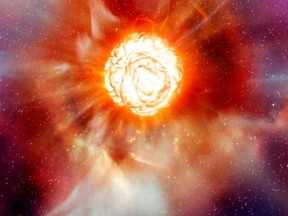In the biggest celestial show ever seen, dying star Betelgeuse will be visible even during the day for several months

Article content
When it happens, it will be the astronomical event of the millennium. Betelgeuse, a red supergiant star in the constellation of Orion the Hunter, will explode into a supernova.
Advertisement 2
Article content
There won’t be any danger to Earth from some 650 light years away, but the dying star will shine almost as brightly as the moon, visible even during the day for several months. When it finally dims it will become invisible to the naked eye. The hunter, known to humans for at least 30,000 years, will have lost a shoulder.
Article content
Now some scientists are predicting that it could happen very soon, perhaps within the next few decades.
In a newly completed study, a team led by Hideyuki Saio of Japan’s Tohoku University suggests that Betelgeuse may be larger, and hence later in life, than other scientists have calculated.
If Saio’s numbers are correct, then the star may have exhausted all its hydrogen and helium – the elements that drive nuclear fusion in our own sun – and may be burning its way through its store of carbon atoms.
Advertisement 3
Article content
“We conclude that Betelgeuse should currently be in a late phase (or near the end) of the core carbon burning,” the paper notes. “After carbon is exhausted in the core, a core-collapse leading to a supernova explosion is expected in in a few tens [of] years.”
To be clear, most scientists assume a slightly smaller size for Betelgeuse, meaning it may have some way to go before a supernova event – perhaps 100,000 years, though that is still a blink of an eye in cosmic terms.
But even there, no one is certain of the exact timing. Predictions amount to a galactic gaming table. Bookmakers favour a tens-of-thousands-of-years timeframe, but there are long-shot odds for, say, next Tuesday.
Advertisement 4
Article content
Part of the problem is that nearby supernovae easily visible to the naked eye are vanishingly rare and hence not well studied. The last time one was observed from Earth was in 1604, four years before the invention of the telescope. (In 1987 a supernova in one of the Milky Way’s companion galaxies was just barely visible from the southern hemisphere, appearing as a new, dim star.)
Regardless of the timing of its eventual fate, the bright star Betelgeuse has given humans something to talk about for millennia. A tiny ivory tablet, more than 30,000 years old, appears to show an image of the constellation of Orion next to a tally of 86 notches, equal to the number of days Betelgeuse is visible in the sky. That’s also the number of days short of a year for human gestation, meaning the star may have been seen as a harbinger of fertility.
Advertisement 5
Article content
More recently, historians have noted that Chinese astronomers of the second century BC referred to the star as having a yellow hue, while four centuries later, Ptolemy of Alexandria was calling it red, suggesting a colour change over that time.
Then in 2019 came “the great dimming.” Scientists think Betelgeuse burped, sending off a huge chunk of its surface area, the resultant dust cloud shrouding its appearance from Earth for two next two years. One can only imagine what an earlier generation of astrologers would have made of the event being followed by a pandemic.
Betelgeuse has since bounced back from its belch, and is just now brighter than usual. (Interestingly, both its dimming and brightening have been seen in various scientific circles as evidence that its end is nigh.)
But beyond the certainty of its eventual demise comes news that scientists expect to detect neutrinos and perhaps gravitational waves about a day before the light of the explosion reaches us. Time enough to haul out the lawn chairs and sit back for the stellar fireworks show.
Article content
https://news.google.com/rss/articles/CBMicGh0dHBzOi8vbmF0aW9uYWxwb3N0LmNvbS9uZXdzL2FzdHJvbm9tZXItcHJlZGljdHMtdGhhdC1hLXJlZC1zdXBlcmdpYW50LXN0YXItbmVhcmJ5LWNvdWxkLWdvLXN1cGVybm92YS12ZXJ5LXNvb27SAQA?oc=5
2023-07-11 15:28:31Z
CBMicGh0dHBzOi8vbmF0aW9uYWxwb3N0LmNvbS9uZXdzL2FzdHJvbm9tZXItcHJlZGljdHMtdGhhdC1hLXJlZC1zdXBlcmdpYW50LXN0YXItbmVhcmJ5LWNvdWxkLWdvLXN1cGVybm92YS12ZXJ5LXNvb27SAQA


Comments
Postmedia is committed to maintaining a lively but civil forum for discussion and encourage all readers to share their views on our articles. Comments may take up to an hour for moderation before appearing on the site. We ask you to keep your comments relevant and respectful. We have enabled email notifications—you will now receive an email if you receive a reply to your comment, there is an update to a comment thread you follow or if a user you follow comments. Visit our Community Guidelines for more information and details on how to adjust your email settings.
Join the Conversation